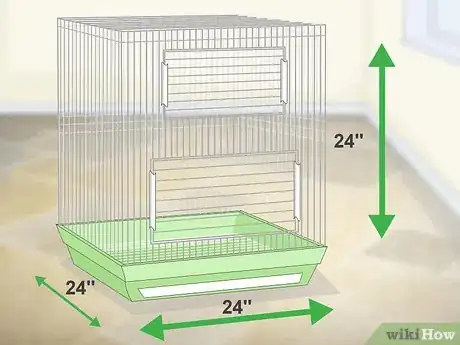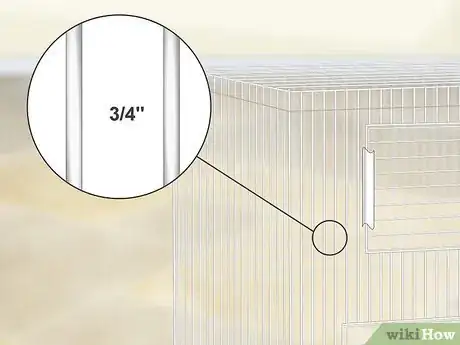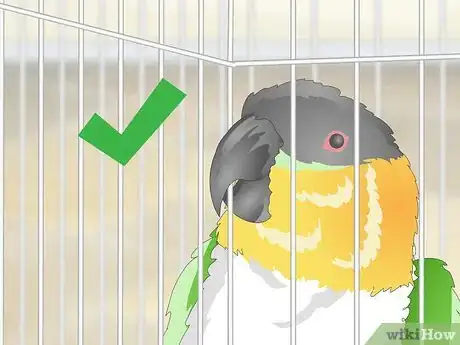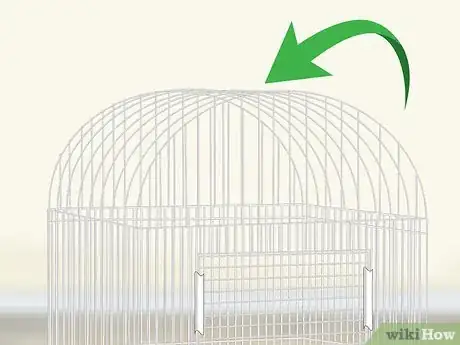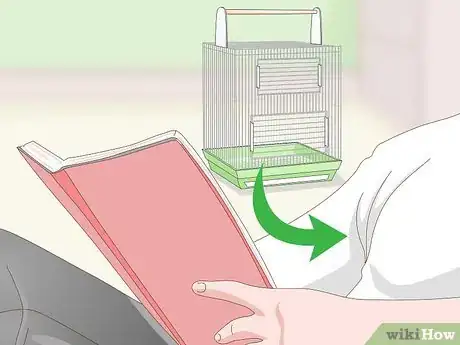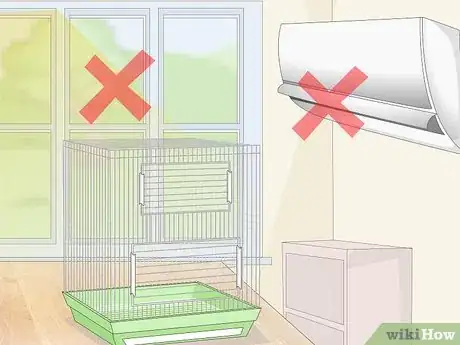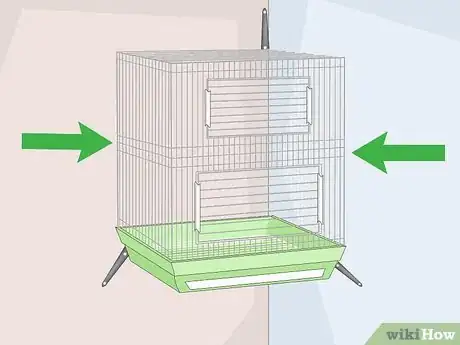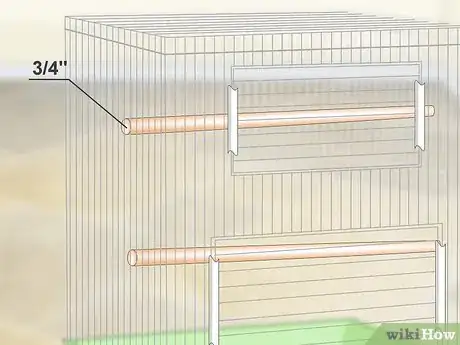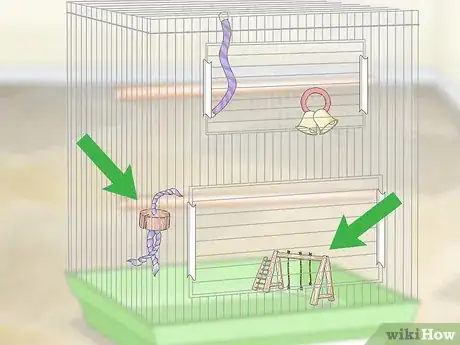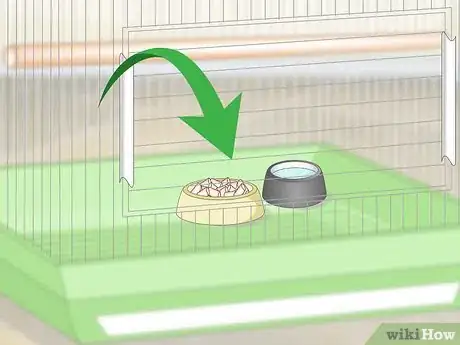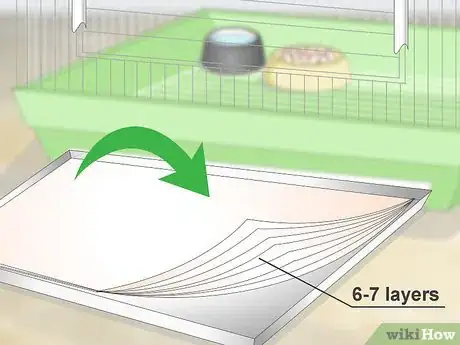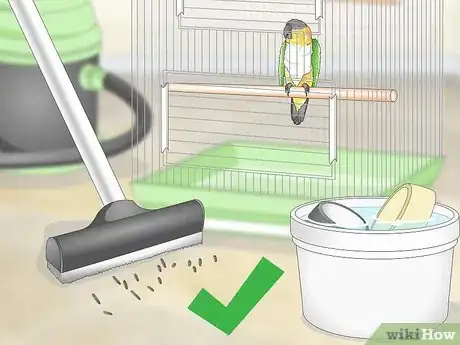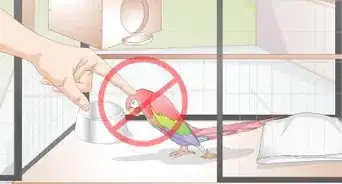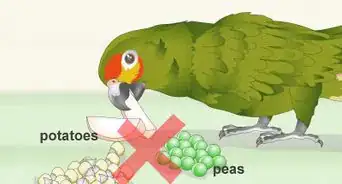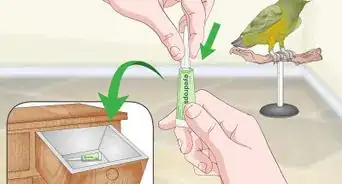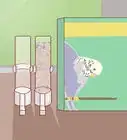This article was co-authored by Melissa Nelson, DVM, PhD. Dr. Nelson is a Veterinarian who specializes in Companion and Large Animal Medicine in Minnesota, where she has over 18 years of experience as a veterinarian in a rural clinic. She received her Doctor of Veterinary Medicine from the University of Minnesota in 1998.
This article has been viewed 14,306 times.
Caique parrots (pronounced “kai-eke”) are charismatic birds who love to play. These energetic parrots need large cages, daily attention, and lots of toys to keep them healthy. By selecting the right cage, finding the best place for it, and properly outfitting it you can create an excellent habitat for your parrot.
Steps
Selecting the Right Cage
-
1Choose a large cage. Although the caique is a medium-sized bird, it needs a great deal of space. Select a cage that can accommodate this energetic parrot. When it comes to caique cages, bigger is always better.[1]
- The smallest cage for a single caique should be 24 x 24 x 24 inches (60 x 60 x 60 cm). A caique in this size cage will need extra time outside of the cage each day.
- A cage-size of 36 x 24 x 48 (91 x 60 x 121 cm), or larger, is ideal.
- Consider both height and width. Caique parrots like flying side-to-side, swinging, and playing Tarzan.
- Caique parrots aren’t the strongest flyers, but they are very strong climbers, and like to walk, hop, and jump. A larger cage will let them climb and hop around comfortably.
-
2Select your bar spacing. Bird cages are made with different sized spaces between the bars. For a caique parrot, a cage bar spacing of around ¾ inch (1.9 cm) is ideal. Additionally, cages that have horizontal (instead of just vertical) bars are great for active caiques to climb on.[2]Advertisement
-
3Choose a metal, chew-resistant cage. Caique parrots love to chew, and they will destroy wooden cages. Opt for a metal cage for your parrots, and avoid painted cages that will chip. Look for a cage that is labeled “chew-resistant.”[3]
- Before you buy a cage, touch and pull on the wires to ensure that they’re sturdy and won’t break.
-
4Try a dometop cage. Dometop cages have a semi-circle of additional space at the top. Since space is such an important issue for caique parrots, most owners tend to lean toward dometop cages. Many people also enjoy the look of dometop cages.[4]
-
5Opt for a playtop cage. Playtop cages are flat, with additional perches and/or toys outside of the cage. Playtop cages are especially attractive for birds who spend a lot of time out their cages. Caiques are known to be a bit mischievous, and usually need to be supervised. If your caique is well-trained (and can be left alone), or if you plan to supervise a lot of out-of-cage time, you may prefer a playtop cage.[5]
Placing the Cage
-
1Choose a place you’ll be in often. You might be tempted to place your parrot’s cage in a back office or bedroom, but this will make it more difficult for your caique to get enough interaction each day. Place your parrot’s cage in a room that you will frequent.[6]
- This helps to better socialize your parrot.
-
2Place the cage where other pets can’t reach. This is especially important if you have a cat that can jump high. While putting the cage on a high counter might protect your bird from dogs, a cat might be able to jump up and bother or even injure your bird. Get a tall, sturdy stand to place your cage from or place barriers around the base of a counter to protect your caique.
-
3Avoid placing the cage near hot or cold drafts. Birds are sensitive to changes in temperature. Place your bird’s cage is a location that does not experience extreme temperature changes.[7] For example, avoid placing the cage near:
- Open windows
- Doors that open to outside
- Heat vents or radiators
- Air conditioners
-
4Avoid smells and fumes. Bird are known for their sensitive respiratory systems, and caique parrots, in particular, do not enjoy powerful odors. Try to set up your bird’s cage in a place that is free from smells, smoke, and other fumes.[8] Some examples include:
- Food odors
- Perfume
- Cigarette smoke
- Fireplace smoke
- Car fumes from your garage
- Strong smells from the backyard
-
5Never place the cage in your kitchen. The fumes that rise when you heat up a non-stick pan on the stove can kill your bird. Keep the cage well away from any area where you’ll be cooking on these pans.[9]
-
6Place the cage against a wall. Many bird owners mistakenly believe that their bird might like to be near a window so they can look outside. Unfortunately, being placed near a window is more likely to startle your bird. Your bird will feel most secure if you place their cage against a wall.[10]
Outfitting Your Cage
-
1Provide at least two perches. Place two perches--sized between ¾ - 1 inch (2 - 2.5 cm)--in your parrot’s cage. One perch should be up high (for roosting), and the other one should be low (near food and water dishes).[11] Caiques love to chew and will do so on the perches. As such, natural perches are best for the bird’s beak. No matter what material you choose, you’ll need to replace the perches when they become very soiled, or if the bird starts to destroy them. Popular materials include:
- Willow
- Poplar
- Wood from fruit trees
-
2Include lots of toys. Caique parrots love to play, and these birds have tons of energy. Caique parrots will need more toys than your average bird to keep them entertained. You will need to experiment a bit to see what kind of toys your parrot enjoys.[12] Some options include:
- Climbing ropes
- Chains
- Bells
- Parrot swings
- Wooden bird toys
-
3Include food and water bowls. Another feature of your bird’s cage will be food and water containers. You can find dishes that mount to the side of your cage, or use dishes that are free standing. For water, you might use a traditional dish or a fountain-style dispenser.
- Some parrot owners like to have two separate food bowls: one for pellets/bird seed, and one for fruits/veggies.
- Caique parrots like to bathe in water. It can be nice to provide a large water dish for bathing and a small one for drinking.
-
4Place a lining on the bottom of the cage. You will need to place some kind of lining on the bottom of the cage to catch droppings, food, and any other debris. Regular newspaper, parchment paper, or any type of paper that is free from pigment will work.
- Some ink pigments can be toxic to birds.
- Try to have 6-7 layers of paper to effectively catch all debris.
-
5Clean the cage regularly. Once your cage is set up the way you (and your bird) like it, all you need to do is a bit of regular maintenance. Keeping a clean and sanitary environment for your caique helps to keep them happy and healthy.
- Liners needs to be changed daily.
- Food and water dishes need to be washed daily.
- The area around the cage should be swept/vacuumed a few times per week.
- Perches should be cleaned a few times a week.
- The entire cage should be sanitized monthly.
References
- ↑ https://www.petcha.com/the-unique-caique/
- ↑ https://www.petcha.com/the-unique-caique/
- ↑ http://animal-world.com/encyclo/birds/Caiques/CaiquesProfile.htm
- ↑ https://www.petcha.com/the-unique-caique/
- ↑ https://www.petcha.com/the-unique-caique/
- ↑ https://www.bird-cage.com/how-to-properly-place-a-parrot-cage-in-a-room-art
- ↑ http://animal-world.com/encyclo/birds/Caiques/CaiquesProfile.htm
- ↑ http://animal-world.com/encyclo/birds/Caiques/CaiquesProfile.htm
- ↑ https://www.ewg.org/research/pfcs-global-contaminants/teflon-and-other-non-stick-pans-kill-birds#.WmaF5ug-e9Z
About This Article
To set up a habitat for your caique parrot, find a cage that's at least 24 inches on all sides, since caique parrots are very energetic birds and need a lot of space. Once you’ve bought your cage, place it in a room where you spend a lot of time, like a living room or kitchen, since caique parrots are social birds and will be uncomfortable in a quiet room. Inside the cage, provide a couple of perches and lots of toys, like chains, bells, and climbing ropes, which your parrot will love to play with. You should also line the cage floor with 6-7 layers of newspaper to make it easier to clean up after your bird. For more tips from our Veterinary co-author, including how to clean your parrot’s cage, read on!
